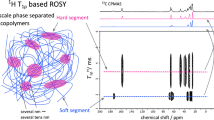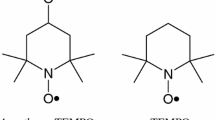Abstract
Relaxation processes in metallocene and Ziegler–Natta isotactic polypropylenes were studied using 1H MAS NMR spectroscopy. 1H MAS NMR spectra and laboratory-frame spin-lattice relaxation times T 1(1H) were measured within the temperature range 30–190 °C, which covers the glass transition relaxation and melting processes of both polymers. Splitting of the peak related to protons in amorphous regions of the studied samples into three sharp peaks at elevated temperatures made it possible to determine the spin-lattice relaxation times T 1(1H) for particular iPP proton groups. The melt-state NMR spectra of ZN-iPP display three sharp peaks with three additional weak peaks positioned on the less shielded side. Entanglements of ZN-iPP chains are suggested as a possible source of these additional peaks. The spectra of m-iPP indicate substantially fewer entanglements due to its lower molecular weight compared with that of ZN-iPP. The temperature dependences of the relaxation times T 1(1H) relating to specific groups of ZN-iPP were shown to reach minima associated with the motions of amorphous chain segments (glass transition relaxation), which are very close to the melting temperature and minima associated with the melting process. Each of the T 1(1H) temperature dependences for m-iPP shows only one minimum associated with the melting process. When the particular relaxation times T 1, min relating to the minima that occur above the melting temperatures were considered, and these relaxation times were compared for the same proton groups in different samples, significant differences in the relaxation times were observed between samples. Polymer chain motion was more restricted in melted ZN-iPP than in m-iPP, as inferred from the T 1, min values.







Similar content being viewed by others
References
Laws DD, Bitter HML, Jerschow A (2002) Solid-state NMR spectroscopic methods in chemistry. Angew Chem Int Ed 41:3096–3129. doi:10.1002/1521-3773(20020902)41:17<3096::AID-ANIE3096>3.0.CO;2-X
Busico V, Cipullo R (2001) Microstructure of polypropylene. Prog Polym Sci 26:443–533. doi:10.1016/S0079-6700(00)00046-0
Geppi M, Harris RK, Kenwright AM, Say BJ (1998) A method for analysing proton NMR relaxation data from motionally heterogeneous polymer systems. Solid State Nucl Magn Reson 12:15–20. doi:10.1016/S0926-2040(98)00046-0
Kienzle U, Noack F, von Schütz J (1970) Kernmagnetische relaxation in festem polypropylen. Koll Z Z Polym 296:129–137. doi:10.1007/BF02086626
McBrierty VJ, Douglass DC, Falcone DR (1972) Nuclear magnetic relaxation in polypropylene. J Chem Soc Faraday Trans II 68:1051–1059. doi:10.1039/F29726801051
Olčák D, Murín J, Uhrin J, Rákoš M, Schenk W (1985) N.M.R. studies of molecular motion in modified polypropylene. Polymer 26:1455–1458. doi:10.1016/0032-3861(85)90076-X
Hatanaka T, Mori H, Terano M (1999) Study of thermo-oxidative degradation of molten state polypropylenes with a variety of tacticities. Polym Degrad Stab 64:313–319. doi:10.1016/S0141-3910(98)00207-9
Vyas PB, Kaur S, Patil HR, Gupta VK (2011) Synthesis of polypropylene with varied microstructure and molecular weights characteristics using supported titanium catalyst system. J Polym Res 18:235–239. doi:10.1007/s10965-010-9411-7
Gómez-Elvira JM, Tiemblo P, Elvira M, Matisova-Rychla L, Rychly J (2004) Relaxations and thermal stability of low molecular weight predominantly isotactic metallocene and Ziegler–Natta polypropylene. Polym Degrad Stab 85:873–882. doi:10.1016/j.polymdegradstab.2004.04.003
Arranz-Andrés J, Peña B, Benavente R, Pérez E, Cerrada ML (2007) Influence of isotacticity and molecular weight on the properties of metallocenic isotactic polypropylene. Eur Polym J 43:2357–2370. doi:10.1016/j.eurpolymj.2007.03.034
Hoyos M, Tiemblo P, Gómez-Elvira JM (2009) Influence of microstructure and semi-crystalline morphology on the β and γ mechanical relaxations of the metallocene isotactic polypropylene. Eur Polym J 45:1322–1327. doi:10.1016/j.eurpolymj.2009.01.018
Hoyos M, Tiemblo P, Gómez-Elvira JM (2007) The role of microstructure, molar mass and morphology on local relaxations in isotactic polypropylene. The α relaxation. Polymer 48:183–194. doi:10.1016/j.polymer.2006.11.034
Fričová O, Uhrínová M, Hronský V, Kovaľaková M, Olčák D, Chodák I, Spěváček J (2012) High-resolution solid-state NMR study of isotactic polypropylenes. Express Polym Lett 6:204–212. doi:10.3144/expresspolymlett.2012.23
Kang J, Gai J, Li J, Chen S, Peng H, Wang B, Cao Y, Li H, Chen J, Yang F, Xiang M (2013) Dynamic crystallization and melting behavior of β-nucleated isotactic polypropylene polymerized with different Ziegler–Natta catalysts. J Polym Res 20:70–80. doi:10.1007/s10965-012-0070-8
Bielecki A, Burum DP (1995) Temperature dependence of 207Pb MAS spectra of solid lead nitrate. An accurate, sensitive thermometer for variable-temperature MAS. J Magn Reson Ser A 116:215–220. doi:10.1006/jmra.1995.0010
Asano A, Hori S, Kitamura M, Nakazawa CT, Kurotsu T (2012) Influence of magic angle spinning on T1 H of SBR studied by solid state 1H NMR. Polym J 44:706–712. doi:10.1038/pj.2012.10
Duer MJ (2004) Introduction to solid-state NMR spectroscopy. Blackwell, Oxford
Kitamaru R (1990) Nuclear magnetic resonance: principles and theory. Elsevier, Amsterdam
Iwata K (2002) Role of entanglement in crystalline polymers 1. Basic theory. Polymer 43:6609–6626. doi:10.1016/S0032-3861(02)00524-4
Olčák D, Ševčovič L, Mucha Ľ, Ďurčová O (1996) NMR study of β relaxation in modified and blended isotactic polypropylene. Polym J 28:232–237. doi:10.1295/polymj.28.232
Ševčovič L, Mucha Ľ (2009) Study of stretched polypropylene fibres by H-1 pulsed and CW NMR spectroscopy. Solid State Nucl Magn Reson 36:151–157. doi:10.1016/j.ssnmr.2009.09.001
Tanaka H, Saito K (1988) Effects of uniaxial stretching and shrinkage on proton spin-lattice and spin-spin relaxation times of isotactic polypropylene. Colloid Polym Sci 266:1–5. doi:10.1007/BF01451525
Bloembergen N, Purcell EM, Pound RV (1948) Relaxation effects in nuclear magnetic resonance absorption. Phys Rev 73:679–712. doi:10.1103/PhysRev.73.679
Hennel JW, Klinowski J (1993) Fundamentals of nuclear magnetic resonance. Longman, Harlow
Van Vleck JH (1948) The dipolar broadening of magnetic resonance lines in crystals. Phys Rev 74:1168–1183. doi:10.1103/PhysRev.74.1168
Schenk W, Ebert A (1980) Untersuchungen zur Molekülbewegung in Polyvinylchlorid mit kernmagnetischen Impulsverfahren. Acta Polym 31:41–46. doi:10.1002/actp.1980.010310108
Acknowledgements
This paper was developed as part of the project named “Centre of Excellence for Integrated Research and Exploitation of Advanced Materials and Technologies in Automotive Electronics,” ITMS 26220120055.
One of the authors (IC) gratefully received financial support of this research from the Slovak Research and Development Agency (grant APVV-0226-06).
Author information
Authors and Affiliations
Corresponding author
Rights and permissions
About this article
Cite this article
Olčák, D., Hronský, V., Fričová, O. et al. Solid and melt-state 1H NMR studies of relaxation processes in isotactic polypropylenes. J Polym Res 20, 117 (2013). https://doi.org/10.1007/s10965-013-0117-5
Received:
Accepted:
Published:
DOI: https://doi.org/10.1007/s10965-013-0117-5




